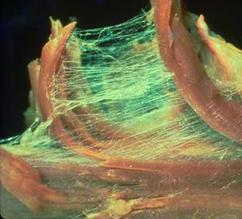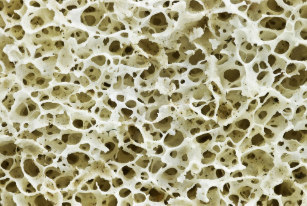Why Are You Working On My Feet When It’s My Low Back That Hurts?
You have probably heard bits of the old song, “the leg bone connected to the thigh bone…” Well, they really are connected – via fascia.
What is Fascia?

Fascia in Muscle Magnified
It’s the white stuff that you see when you cut into a piece of meat. We humans have it, too, and it’s everywhere in the body. It surrounds your organs, your muscles, and your bones, it’s also within all the muscles. In fact, if you took away everything else in the body and left only the fascia, it would still look like a human body. Fascia is ubiquitous in the body.
According to Tom Myers, the author of Anatomy Trains, fascia connects one muscle to another, even across bones. The anatomy books often show the muscles as if one ends, then there is a little gap, then another muscle begins. In reality, they are connected with fascia that runs from one muscle to the next. Our feet really are connected to our heads.
In his introduction to The Extracellular Matrix and Ground Regulation by Alfred Pischinger, James Oschman notes that, “The matrix is not an inert filler substance or filter, but is instead a body-wide communication and support system, vital to all functions. Pischinger further indicates “The fascia forms the largest system in the body as it is the system that touches all the other systems.”
Fascia is a matrix that is composed of tiny fibers and a mucus-like substance. It has a lattice structure that you can see in the photo above. It also has semi-conducting properties that provide communication throughout the body. It is possible that acupuncture works via the fascial system.
What Does Fascia Have to do with my Pain?
The fascial system is constantly altering itself to support the structural needs of the body. One function of fascia is to provide stability and support for your habitual postures and movements. For example, if you like to sit at your desk leaning to your left, resting on your left elbow while you work, your body will help you to do that comfortably by laying down extra fascia in certain locations in your body. This fascia is aligned in the directions necessary to support that posture.
The problem is that after years of this process, this fascia ends up restricting normal movement and you can no longer straighten out completely. It feels as if your muscles are stiff, but it’s not the muscles – it’s the fascia that won’t allow the muscles to release. There is a fine line between a little bit of extra stability and immobility.
As a bonus, this fascia over time can cause twists, pulls and drags on all the other soft tissues and even on the bones and internal organs. These eventually cause pain and restriction far from where the original problem is.
So try this: if you’re wearing a tee shirt or other shirt with some stretch, tug on it at the hem on the right side at your waist. Look at what happens to the material at the left shoulder or the right shoulder or the neck, depending on the angle of your tug. See the ripples that travel all the way up to the neck? Fascia does exactly the same thing in the body. A restriction in the tissue at the ankle can cause a tug that travels all the way up the legs and through the hips to the back. It can cause twists and restrictions in muscles that then cause your pain, all far away from the actual problem.
Now Let’s Talk about Bones
Fascia also surrounds the bones – it’s called the periosteum. The tendons and ligaments that we think of as attaching to the bones actually attach to the periosteum. One colleague of mine, who is a massage teacher, illustrates the periosteum by wrapping dryer sheets around the bones of the class skeleton. The periosteum can get twisted and restricted just like fascia elsewhere in the body. It can eventually cause twists in the bone tissue itself.

Bone Structure Magnified
And speaking of bones – we think of bones as solid dense structures. In fact, bone tissue consists of the same fascial matrix as soft tissue, but with calcium crystals in it that make it harder. It’s also a lattice structure – not completely solid, as you can see in the picture above. Bone tissue can become twisted (albeit only slightly) just like other tissue, depending on our postures and activities. Twists in bones can also be the reason for knots in your muscles.
My own experience is a perfect example of a twist in bone tissue that caused a restriction in the muscle. I had a knot in my inner thigh muscle at about mid-thigh that no amount of bodywork would correct. I and several colleagues worked and worked on this muscle over the course of a couple of years with no lasting results. I went for a treatment from my teacher who developed the Spontaneous Muscle Release Technique (SMRT). She found that I had a twist in the femur (thigh) bone right at the spot where that muscle was bunched up. She applied SMRT for 20 seconds on the bone that released the twist and the muscle relaxed immediately. That knot has never returned. After some discussion about other issues she was seeing in my body, I realized that the twist was a result of how I liked to sit in my car while driving – for the previous nine years!
The Movement Connection
One of my teachers says that when clients come to her with low back pain, the key to resolving the pain long-term for more than half of them is addressing and treating issues in the feet.
This is partially because of the direct fascial connection between the feet and the low back. However, there is also a movement connection. If there is a problem with your foot and you adjust your gait (walking pattern) to compensate for the foot problem, you will likely use muscles in your hips and low back to lift your leg up to walk instead of pushing off from the ball of your foot. These muscles weren’t designed to be used that way, so a common consequence years later is a chronic muscle imbalance that either causes pain or sets the stage for an injury.
This kind of adjustment often happens subconsciously. The body’s ability to adapt is amazing, but it is also a double-edged sword because it adapts without you being conscious of the change. If you’re not aware of how you are compensating, then you’re probably not going to be aware of the changes that occur in your body because of the compensation. Then twenty years later you have back pain, or you strain your back with a simple movement like opening the shower curtain, and don’t understand why.
How my Treatments can Help
I recently treated a 39-year-old woman who is a professional dancer. She has been dancing since she was seven years old. She started with ballet and then branched out into a variety of types of dancing. Her movements are incredibly graceful. However, she complained of hip and low back pain, as well as stiffness and pain in her feet.
Palpation of her hips and legs revealed that all the tissue on the inside of her legs was pulled up toward her hips, while the tissue on the outside of her legs was pulled down toward her feet. The tissue in her inner thighs was twisted toward the front and around to the outside of her body on both legs. Of course, her feet were stuck in plantar flexion (pointed) from years of dancing on her toes, and her midfoot lacked mobility on both sides. SMRT treatment of these issues provided a lot of relief for her after only one treatment.
SMRT is the perfect technique to address these restrictions in fascial and bone tissue, as well as muscles, tendons and ligaments. It is gentle, almost painless, and it works with the nervous system so the treatment is incredibly relaxing while achieving lasting results.
 Thanks for reading!
Thanks for reading!
Dr. Carol
